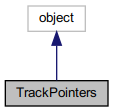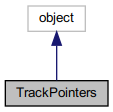Track pointers for the glove/hand and the puzzle pieces.
More...
|
| def | __init__ (self, iState=None, trackCfg=None) |
| | Constructor for layered puzzle scene tracker. More...
|
| |
| def | adapt (self) |
| | Adapt the layer detection models. More...
|
| |
| def | correct (self) |
| | Apply correction process to the individual detectors. More...
|
| |
| def | display_cv (self, I, ratio=None, window_name="trackpoints", doRotate=False) |
| |
| def | emptyDebug (self) |
| |
| def | emptyState (self) |
| | Get empty puzzle scene track state. More...
|
| |
| def | getDebug (self) |
| |
| def | getState (self) |
| | Get the complete detector state, which involves the states of the individual layer detectors. More...
|
| |
| def | info (self) |
| |
| def | measure (self, I) |
| | Apply detection to the source image pass. More...
|
| |
| def | predict (self) |
| | Generate prediction of expected measurement. More...
|
| |
| def | process (self, I) |
| | Apply entire predict to adapt process to source image(s). More...
|
| |
Track pointers for the glove/hand and the puzzle pieces.
◆ __init__()
| def __init__ |
( |
|
self, |
|
|
|
iState = None, |
|
|
|
trackCfg = None |
|
) |
| |
Constructor for layered puzzle scene tracker.
- Parameters
-
| [in] | iState | Initial state of tracks. |
| [in] | trackCfg | Trackpointer(s) configuration. |
◆ adapt()
Adapt the layer detection models.
There is no adaptation.
◆ correct()
Apply correction process to the individual detectors.
Apply naive correction on a per detector basis. As a layered system, there might be interdependencies that would impact the correction step. Ignoring that for now since it does not immediately come to mind what needs to be done.
◆ display_cv()
| def display_cv |
( |
|
self, |
|
|
|
I, |
|
|
|
ratio = None, |
|
|
|
window_name = "trackpoints", |
|
|
|
doRotate = False |
|
) |
| |
◆ emptyDebug()
◆ emptyState()
Get empty puzzle scene track state.
- Parameters
-
| [out] | estate | The empty state. |
◆ getDebug()
◆ getState()
Get the complete detector state, which involves the states of the individual layer detectors.
- Parameters
-
| [out] | state | The detector state for each layer, by layer. |
◆ info()
◆ measure()
Apply detection to the source image pass.
- Parameters
-
| [in] | I | Layered detection image instance (structure/dataclass). |
◆ predict()
Generate prediction of expected measurement.
The detectors are mostly going to be static models, which means that prediction does nothing. Just in case though, the prediction methods are called for them.
◆ process()
Apply entire predict to adapt process to source image(s).
- Parameters
-
| [in] | I | Layered detection image instance (structure/dataclass). |
◆ glove
◆ pieces
The documentation for this class was generated from the following file:

